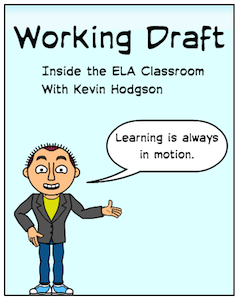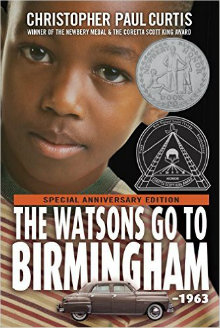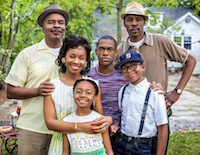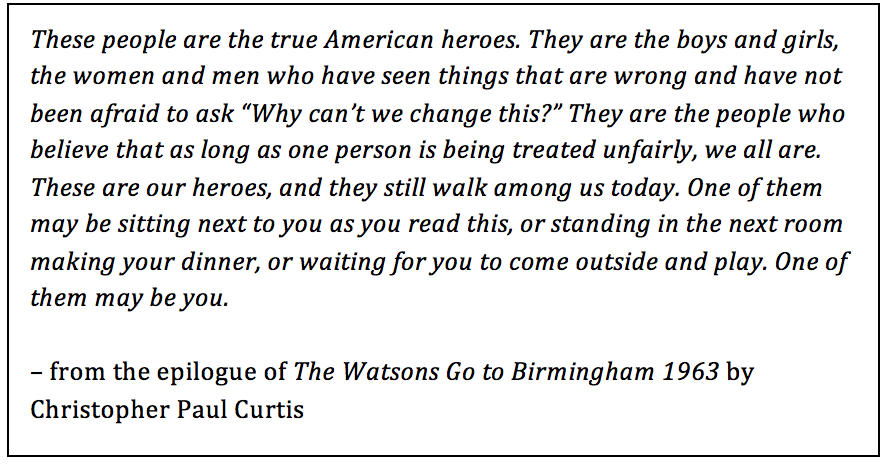Teaching “The Watsons Go to Birmingham”
A MiddleWeb Blog

It’s the explosion scene, when white supremacists purposely bomb a Birmingham, Alabama church where the narrator’s young sister has gone for her Sunday School class. When I read these events out loud, when the horror of what has just happened suddenly hits the reader, you can hear a pin drop in the classroom. Every student is full-on listening.
I’ve now read that chapter many, many times, and still, I can barely control the trembling emotions in my voice as 10-year-old Kenny, the narrator, wanders through the bombed out church basement in a post-traumatic trance, seeing the bodies of victims and the damage wrought by violence, but not registering the reality of it. My voice cracks on the words.
I want to reach out to Kenny, every time. I want to hug him, hold him, protect him.

I think we’re all grateful that Joetta has survived, yet we remain stunned by the violence aimed at children. I then guide my students back to the dedication page at the front of the book, where writer Christopher Paul Curtis honors four young girls – some not much older than my own sixth graders – who died in the bombing of 16th Street Baptist Church in Alabama on Sept. 15, 1963. The book is fiction, informed by history, and that makes it even a more powerful read.
“They’re our age,” one student murmured the other day. More silence.
Experiencing the book together
When I hear in education circles that some fourth graders read this book on their own as independent reading, I can’t help by wonder: who will guide those students to understand not just the fictional scene that unfolds but also the connections to the real world, and the terrible toll that the Civil Rights Movement took on real people, real families, real lives.
Who will answer their questions? Who will probe them to think about the world today? The world tomorrow? Who will help explain why writer Christopher Paul Curtis shifts the tone of the novel so dramatically, from the humorous start that focuses on the dynamics of the Watson family, to the heart-clutching ending?
Who will give them a hug, if they need it?
My hope in teaching this book is that my students and I come out of a powerful literary experience like this with a better sense of the price of racism in the world, so that they can at least better recognize racial hatred when it shows its ugly face; not be a part of it if it comes into their life; and ideally, battle racism at its roots on their own terms.
That’s a lot to ask of 12 year olds, I know. Luckily, Christopher Paul Curtis has provided the inroad with what was his very first novel – which holds up admirably over time.
Expanding the experience
This year, I took the discussion of that chapter and the novel a few steps further. As I noted in my last column here at MiddleWeb, I have been co-facilitating a graduate course around using the United States Library of Congress digital archives to bring more primary sources into the classroom.
As teacher participants were working on their own projects — ranging from the Dust Bowl, to Darwin’s ideas of evolution, to the opening of King Tut’s tomb, and more – I have been doing my own exploration of the Civil Rights era.
My main focus has been finding primary sources that facilitate the exploration of the role that young people played in the Civil Rights Movement, particularly in the Children’s March, also known as the Children’s Crusade, in Birmingham in 1963. While the Watsons book does not mention the March, the movie version does, using archival television footage. My students are often riveted by the images of young people marching together and facing down police, dogs, batons and water cannons.
I supplement that footage with multiple texts and sources – from primary documents of the petition to march, to a non-violent declaration by a southern youth group, to an interview with a man who was in the march at age 12, and more. We watch other short videos and read a news piece from Biography published on the anniversary of the Children’s March.
Just like when there’s a time that a smart person knows enough is enough, there’s a time when you know you’ve got to fight.” – Christopher Paul Curtis.
The conclusions students reach
All of it is designed to enrich their understanding of the time, and then, they have to craft a short argumentative piece of writing that uses evidence and materials from at least three of the sources of material. The argument? Should young people have been involved in the Civil Rights protests of the 1960s, given the dangers of political action?

But they can do it. They did do it. And hopefully, they have a better understanding of the sacrifices and bravery of those who got involved to make change in the world. Maybe, as Christopher Paul Curtis notes in a powerful epilogue that reminds readers of the real events which influenced the story he tells, someday, the people – the heroes – who make the change … might be them.






































